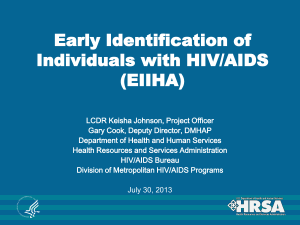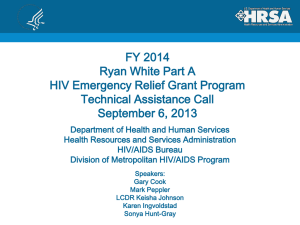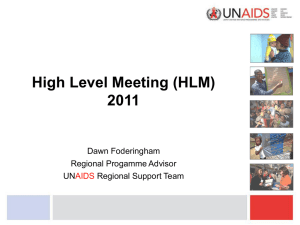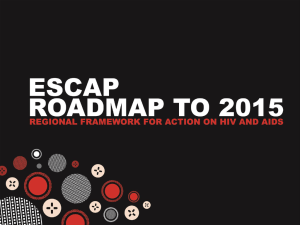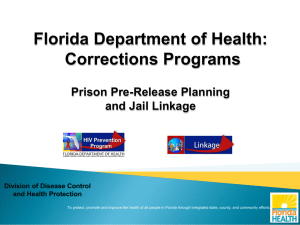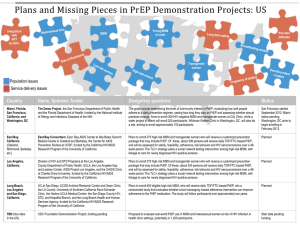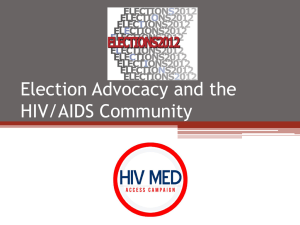Highlights FY 2015 FOA
advertisement
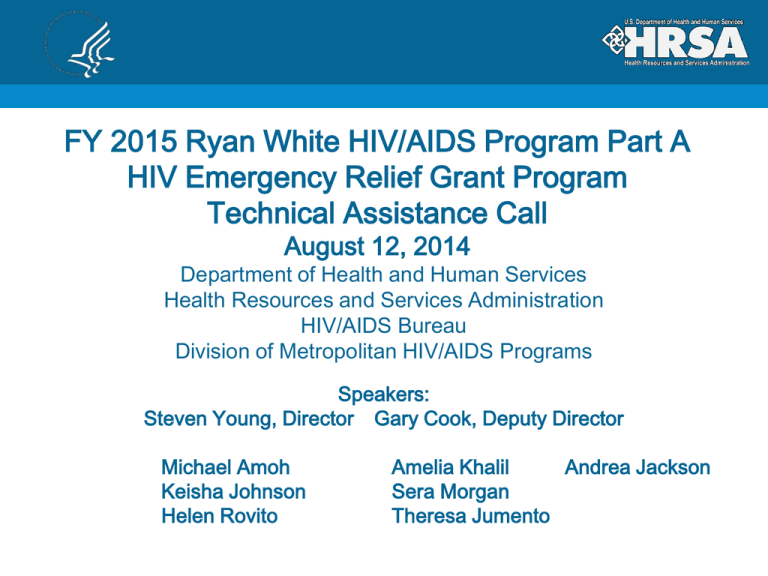
FY 2015 Ryan White HIV/AIDS Program Part A HIV Emergency Relief Grant Program Technical Assistance Call August 12, 2014 Department of Health and Human Services Health Resources and Services Administration HIV/AIDS Bureau Division of Metropolitan HIV/AIDS Programs Speakers: Steven Young, Director Gary Cook, Deputy Director Michael Amoh Keisha Johnson Helen Rovito Amelia Khalil Andrea Jackson Sera Morgan Theresa Jumento Agenda Welcome Purpose of Webinar Program Information Application Due Date and Award Date Highlights of FY 2015 Funding Opportunity Announcement (FOA) • Section Overview • Questions & Answers • Program Contact Information • • • • • Purpose of the Webinar The purpose of this webinar is to provide: • Technical assistance • General information • Answers to questions received from all eligible metropolitan areas relative to HRSA-15-003 Program Information • Approximate funding for FY 2015 – $618,492,359.00 • Available to 52 grantees • Ryan White HIV/AIDS Program (RWHAP) legislation (Sec. 2603 (a)(4)) of the Public Health Service Act hold harmless will not be a factor in the FY 2015 Ryan White HIV/AIDS Program Part A awards • Information on RWHAP and the Affordable Care Act, along with Policy Clarification Notices, can be found at http://hab.hrsa.gov/affordablecareact/ • Information on the National HIV/AIDS Strategy (NHAS) is located in the SF-424 Application Guide Due and Award Dates • Application Due Date September 19, 2014 by 11:59 PM EST • Project Period March 1, 2015 – February 29, 2016 Highlights FY 2015 FOA Highlights FY 2015 FOA • Reorganized Needs Assessment o New Sections: Impact of Affordable Care Act (ACA) Minority AIDS Initiative (MAI) • Streamlined Methodology • Modified Workplan o New Section: HIV Care Continuum Highlights FY 2015 FOA • Clarified Evaluation and Technical Support Capacity of Clinical Quality Management (CQM) • Refined Organizational Information • Review Criteria Recalculated Section Overview Section Overview Needs Assessment Jurisdictional Profile • Describe the population of persons with HIV/AIDS using epidemiological data • In section 1(1) of the jurisdictional profile, provide both HIV and AIDS incidence and prevalence for calendar years (CY) 2011, 2012, and 2013 • Sample table below illustrates how data may be presented in the FOA: CY 2011 Incidence HIV AIDS Prevalence CY 2012 Incidence Prevalence CY 2013 Incidence Prevalence Section Overview Needs Assessment Demonstrated Need • 5 sections: Unmet Need, Early Identification of Individuals with HIV/AIDS (EIIHA), Unique Service Delivery Challenges, the Minority AIDS Initiative (MAI) and Impact of Funding • “New/Emerging Populations” o Include in FY 2015 FOA only if significant changes/ new communities were noted from previous FOAs • Unmet Need o Comprised of 3 sections: CY 2013 Unmet Need estimate (Attachment 4) Unmet Need trends (2011, 2012, 2013) Description of how Unmet Need data are considered during planning and decision making process Section Overview Needs Assessment Minority AIDS Initiative • New section in FY1205 FOA • Three (3) components: 1. Identify minority populations living with HIV and the specific sub-groups 2. Describe how MAI funds were considered during the planning process and service categories funded; describe how services differ from Part A services 3. Describe two (2) funded MAI activities Section Overview Needs Assessment Early Identification of Individuals with HIV/AIDS (EIIHA) 1. Legislation 2. EIIHA Components a) b) EIIHA Data EIIHA FY 2015 Plan 3. EIIHA Scoring 4. FY 2013 Progress Report (not part of the FY 2015 FOA) Section Overview Needs Assessment EIIHA - Part A Legislation • Part A Legislation Section 2602 (b)(4)(A)(B)(C)(D): o “…shall determine size and demographics of the estimated population of individuals with HIV/AIDS who are unaware of their HIV status” o “determine the needs of…individuals with HIV/AIDS who do not know their HIV status” o “develop a comprehensive plan…that includes – “ “a strategy, coordinated as appropriate with other community strategies and efforts, including discrete goals, a timetable, and appropriate funding, for identifying individuals with HIV/AIDS who do not know their HIV status, making such individuals aware of such status, and enabling such individuals to use the health and support services” Section Overview Needs Assessment EIIHA Components • EIIHA for FY 2015 will have 2 components: 1. EIIHA Data 2. FY 2015 EIIHA Plan Section Overview Needs Assessment EIIHA • Select 3 target populations from FY 2014 EIIHA Plan • Provide data from January 1, 2014 – June 30, 2014 (or most recent 6-month period) • Definitions are outlined in the FOA • Data collection, analysis, usage Section Overview Needs Assessment EIIHA • • • Describe the planned activities for FY 2015 Include all populations for the EIIHA Plan Describe how the overall FY 2015 EIIHA Plan contributes to the NHAS and White House Continuum of Care Initiative o • Link: http://www.whitehouse.gov/the-pressoffice/2013/07/15/executive-order- hiv-care-continuum-initiative. Describe how the EIIHA Plan for FY 2014 influenced the development of the plan for FY 2015 Section Overview Needs Assessment EIIHA • Select target populations for FY 2015 (may be previously described populations) • Describe plans to present, discuss, and/or disseminate the EIIHA Plan and outcomes of your plan activities to stakeholders (e.g., poster presentations, journal articles, presentations to planning bodies) Section Overview Needs Assessment EIIHA Scoring • EIIHA section will be scored the same as in past FOAs o 33 points total EIIHA Data – 14 points EIIHA FY 2015 plan – 19 points Section Overview Needs Assessment EIIHA Reporting Dates Funding Opportunity Announcements Progress Reports Progress report due date FY 2015 FOA EIIHA Data – January 1-June 30, 2014 FY 2015 Progress Report EIIHA Data – January 1December 31, 2014 2016 FY 2014 FOA EIIHA Data-January 1-June 30, 2013 FY 2014 Progress Report EIIHA Data-January 1-December 31, 2013 July 30, 2015 FY 2013 FOA EIIHA Data-Partial 2012 FY 2013 Progress Report January –December 2012 July 30, 2014 Section Overview Needs Assessment Impact of Funding • Expanded section in FY15 FOA • Impact of the Affordable Care Act 1. 2. 3. 4. 5. Uninsured and poverty Impact of insurance expansion Outreach and enrollment Marketplace options Successes/Outcomes Section Overview Needs Assessment Impact of Funding • Impact and response to reduction in Ryan White HIV/AIDS Program formula funding • Impact of co-morbidities on the cost and complexity of providing care • Coordination of services and funding streams Section Overview Needs Assessment Section Overview Section Overview Letter of Concurrence Planning councils (PC) and planning bodies (PB) must respond to the following: 1.FY 2014 formula, supplemental and MAI funds are being expended in keeping with PC or PB priorities 2.All Conditions of Award relative to the PC or PB have been addressed 3.Priorities were established by PC or PB in keeping with approved processes 4.Annual PC or PB training took place – include dates 5.PC or PB membership is reflective of the EMA/TGA ** Include plan and timeline for addressing each vacancy Section Overview Community Input Process Community Input Process • Description of priority setting and resource allocation process (PSRA) See a-j, pg. 19 • How data from Part A and other Federal programs was used during the PSRA processes • How these data may be linked to future health outcomes Section Overview Section Overview Workplan U.S. HIV Care Continuum Source: http://aids.gov/federal-resources/policies/care-continuum/ Section Overview Workplan HIV Care Continuum • Provide a graph which depicts the RWHAP Part A HIV Care Continuum in the EMA/TGA o Include baseline data for CY 2013 or the most recent calendar year for each stage of the HIV Care Continuum o Use Ryan White Services Report (RSR) data or any available data as a baseline for Ryan White HIV/AIDS Program-eligible individuals o Clearly cite data sets used o Clearly describe the numerator and denominator Section Overview Workplan HIV Care Continuum Narrative which addresses how the HIV Care Continuum will be used in: • Planning, prioritizing, targeting and monitoring resources • Reducing health disparities • Reducing challenges and barriers around data sharing and collaboration with local, state and Federal partners Section Overview Workplan Implementation Plan • Two components: o Service Category Table o HIV Care Continuum Table • Both sections are included as Attachment 9 Section Overview Workplan Attachment 9 Section Overview Workplan Section Overview Workplan SAMPLE FORM Ryan White Part A Implementation Plan: HIV Care Continuum Grantee Name: Big City EMA Fiscal Year: 2015 Stages of the HIV Care HIV Care Continuum Continuum Goal I. Diagnosed Increase in the percentage of clients who are aware of their HIV Status II. Linked to Care III. Retained in Care IV. Prescribed ART V. Virally Suppressed Increase in the percentage of clients linked to care Increase in the percentage of clients retained in care Increase in the percentage of clients with access to prescribed HIV/AIDS medications consistent with PHS Treatment Guidelines Increase in the percentage of clients with a viral load of <200 Outcome Service Category (One or more may apply) HIV Positivity* Late HIV Diagnosis* Early Intervention Services Baseline: Numerator/Dominator, % Target: Numerator/Dominator, % 7/10 9/10 90% 70% Linkage to HIV Medical Care* Outpatient Medical Care Medical Case Management Medical Transportation Baseline: Numerator/Dominator, % Target: Numerator/Dominator, % 67/100 87/100 67% 87% Retention in HIV Medical Care* HIV Medical Visit Frequency** Outpatient Medical Care Medical Case Management Medical Transportation Baseline: Numerator/Dominator, % Target: Numerator/Dominator, % 58/100 72/100 58% 72% Antiretroviral Therapy (ART) Among Persons in HIV Medical Care* Prescription of HIV Antiretroviral Therapy ** Baseline: Numerator/Dominator, % Target: Numerator/Dominator, % 76/100 92/100 92% 76% Viral Load Suppression Among Persons in HIV Medical Care* HIV Viral Load Suppression** Baseline%: 45/100 Target: Numerator/Dominator, % 45% 80/100 80% * HHS Measures can be found at http://www.aids.gov/pdf/hhs-common-hiv-indicators.pdf ** HAB Core performance measures can be found at: http://hab.hrsa.gov/deliverhivaidscare/coremeasures.pdf Outpatient Medical Care Medical Case Management Medical Transportation Outpatient Medical Care Medical Case Management Medical Transportation Treatment Adherence Counseling Section Overview Resolution of Challenges • Discuss challenges encountered in integrating the HIV Care Continuum into the planning and implementation of your Part A program • Describe approaches used to resolve these challenges Section Overview Section Overview Organizational Information • Grantee Administration • Grantee Accountability o Program Oversight o Fiscal Oversight • 3rd Party Reimbursement • Maintenance of Effort • Budget and Budget Justification Narrative Section Overview Organizational Information Budget Justification Narrative – Attachment 12 •Specific, detailed justifications for all allocated items in the program-specific line item budget •Clearly state how each object class category’s efforts and/or activities make a contributing impact to support the Part A HIV service delivery system •Applicants are strongly encouraged to use the suggested template, Budget Justification Narrative (Attachment 12), to respond to the Budget Justification Narrative section of the FOA. A sample of the suggested template is attached and will be available for download during the webinar Section Overview Organizational Information Budget Narrative 1)Description of how the amounts requested for line item in the budget will support the achievement of the proposed objectives 2) Clearly explain how each activity impacts the Part A HIV service delivery system Under the Personnel Object Class Category, all costs must include the name, position title, and FTE allotment. Section Overview Organizational Information Cost Categories - Salary Limitations Requirement (Appropriations Act 2013) Salaries charged to Individual’s base HHS grants may not salary, exclusive of Applies to exceed $181,500 fringe benefits and subcontracts annually outside income earned Section Overview Section Overview Evaluation and Technical Support Capacity Clinical Quality Management • CQM section has four components: 1. 2. 3. 4. CQM Infrastructure CQM Program Performance Measures CQM Program Quality Improvement Data for Program Reporting Review Criteria Review Criteria Criterion Points Subsets 1. Need 67 Jurisdictional Profile: 7 Demonstrated Need: 7 EIIHA : 33 Unique Service Delivery Challenges: 2 MAI: 6 Impact of Funding: 12 2. Response 15 Planning & Resource Allocation: 6 Care Continuum and Implementation Plan: 8 Resolution of Challenges: 1 3. CQM 5 Infrastructure, Performance measurement & QI: 5 4. Resources/ Capabilities 10 Program Organization: 2 Program Accountability: 8 5. Support Requested 3 Budget and MOE: 3 1 Review Criteria Review Criteria C1: Need 2014 FOA 34 2015 FOA 67 Includes EIIHA C2: Response C3: Evaluative Measures 13 5 15 5 C4: Resources/Capabilities 10 10 C5: Support Requested 5 3 33 100 N/A 100 C6: EIIHA TOTAL Review Criteria EIIHA • Worth 33 points by legislative mandate • Focus on 3 targeted populations • Data (a-g) = 14 points ** Use January 1 – June 30 data** • EIIHA Plan = 19 points Review Criteria New Items: Impact of the Affordable Care Act – 4 points Minority AIDS Initiative – 6 points HIV Care Continuum and Implementation Plan – 8 points Items NOT Scored: HIV Care Continuum Table Applicants will not be penalized for not having access to the most recently requested data Reporting Requirements Reporting Requirements FY 2014 Part A Grant Requirements Calendar FY 2013 Requirements Contents Submission Due to EHB July 30, 2014 Requirement Type FY 2013 Annual Progress Report Annual Progress Report Format & WICY Table FY 2013 Final FFR and Carry Over July 30, 2014 Condition FY 2013 Part A & MAI Expenditure Table July 30, 2014 Reporting Requirement Final FY 2013 MAI Annual Report for period 3/1/2013 to 2/28/2014 January 31, 2015 Reporting Requirement FY 2014 Requirements Contents Requirement Type FY 2014 Program Term Report REVISED: SF 424A, Budget Narrative, Implementation Plan, CLC, CRC, & FY 2014 Part A & MAI Planned Allocation Table, Planning Council Roster, LPAP Profile (new) (Send Planning Council Co Chairs signed letter endorsing the allocations and program priorities) Final FY 2014 MAI Annual Plan for the use of the Part A MAI funds for period 3/1/2014 to 2/28/2015 UOB Estimates and Estimated Carryover Ryan White Services Data Report (RSR) Submission Due to EHB August 15, 2014 July 18, 2014 Reporting Requirement December 31, 2014 March 30, 2015 Reporting Requirement Reporting Requirement FY 2014 Final FFR and Carry Over July 30, 2015 Condition FY 2014 Part A & MAI Final Expenditure Table Final FY 2014 Part A Annual Progress Report & Expenditure for WICY (see NOA for additional details) FY 2014 MAI Annual Report July 30, 2015 Reporting Requirement July 30, 2015 Reporting Requirement January 31, 2016 Reporting Requirement Federal Financial Report, FFR (SF 425) FY 2013 Part A & MAI FINAL Expenditure Report Final FY 2013 MAI Annual Report Final FY 2014 MAI Annual Plan Unobligated Balances (UOB) Ryan White Services Data Report (RSR) Federal Financial Report, FFR (SF 425) FY 2014 Part A & MAI Final Expenditure Table Final FY 2014 Part A Annual Progress Report MAI Annual Report Reporting Requirement Reporting Requirement Questions & Answers Program Contacts HAB/DMHAP Contact Steven R. Young, MSPH Director, Division of Metropolitan HIV/AIDS Programs 5600 Fishers Lane, 09W03 Rockville, Maryland 20857 Email: Syoung@hrsa.gov Telephone: (301) 443-6745 Fax: (301) 443-8143 Please continue to submit specific questions through your assigned Project Officer. These will be combined with others with answers posted and circulated to all eligible areas. Technical Assistance Website: http://www.careacttarget.org
